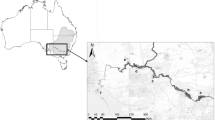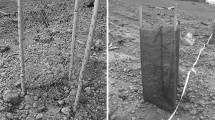Abstract
Marram grass (Ammophila arenaria L. Link (marram grass; Poaceae) has been identified as a major threat to the biodiversity of temperate dune systems outside its natural range. Coastal management and conservation agencies in a number of countries have invested in dune restoration programs involving the removal of invasive species, including marram grass. We investigate the age, viability and the depth distribution of buried seeds of this dune grass within two foredunes in southern New Zealand. The germinability of seeds of known age was determined at St Kilda Beach, Dunedin, New Zealand, to derive a minimum age for the seedbank. Seed was extracted by coring through a foredune to layers of sand of known age based on a time series of foredune-beach profiles. The potential of marram grass to develop large seedbanks in ideal conditions of vigorous plant growth and rapid foredune accretion, was investigated at Mason Bay. Buried seed was extracted using hand-corers to a maximum depth of 4.01 m and tested for germinability. A high proportion of excavated A. arenaria seeds were viable at both sites, including seeds recovered from 4 m depth at St Kilda, estimated to be at least 21 years old. We found no trend of declining viability with increasing depth at Mason Bay, suggesting seed may remain viable for longer than 21 years. Persistent, long-lived, seed banks of A. arenaria develop in foredunes. Restoration programs aiming to eradicate this species are likely to be prolonged (years to decades) as a result of regeneration from seeds that re-enter the shallow seed bank as dunes erode.






Similar content being viewed by others
References
Baker HG (1989) Some aspects of the natural history of seed banks. In: Leck MA, Parker VT, Simpson RL (eds) Ecology of Soil Seed Banks. Academic Press, San Diego, pp 9–21
Bakker JP, Poschlod P, Strykstra RJ, Bekker RM, Thompson K (1996) Seed banks and seed dispersal: important topics in restoration ecology. Acta Botanica Neerlandica 11:461–490
Baptista TL, Shumway SW (1998) A comparison of the seed banks of sand dunes with different disturbance histories on cape cod national seashore. Rhodora 100:298–313
Baskin CC, Baskin JM (1988) Germination ecophysiology of herbaceous plant species in a temperate region. Am J Bot 75:286–305
Bencie R (1990) Investigation of seedling emergence and seed bank of Ammophila arenaria. Unpublished report, The Nature Conservancy, Arcata, California
Brock MA, Theodore K, O’Donnell L (1994) Seed-bank methods for Australian wetlands. Aust J Mar Freshwat Res 45:483–493
Buell AC, Pickart AJ, Stuart JD (1995) Introduction history and invasion patterns of Ammophila arenaria on the north coast of California. Conserv Biol 9:1587–1593
Ge X, Liu J, Wang R (2013) Effects of flooding on the germination of seed banks in the Nansi Lake wetlands, China. J Freshw Ecol 28:225–237
Gemmell AR, Greig-Smith P, Gimingham CH (1953) A note on the behaviour of Ammophila arenaria (L.) link in relation to sand dune formation. Trans Proc Bot Soc Edinb 36:132–136
Hendry GAF, Grime JP (1993) Methods in comparative plant ecology: a laboratory manual. Chapman and Hall, London
Hertling UM, Lubke RA (1999) Use of Ammophila arenaria for dune stabilisation in South Africa and its current distribution — perceptions and problems. Environ Manag 24:467–482
Hesp P (1988) Morphology, dynamics and internal stratification of some established foredunes in Southeast Australia. Sediment Geol 55:17–41
Hesp P (2002) Foredunes and blowouts: initiation, geomorphology and dynamics. Geomorphology 48:245–268
Hilton MJ (2006) The loss of New Zealand’s active dune systems and the spread of marram grass (Ammophila arenaria). N Z Geogr 62:105–120
Hilton MJ and Konlechner TM (2010) A review of the marram grass eradication program (1999–2009), Stewart Island, New Zealand. Proceedings of the 17th Australasian weeds conference. Christchurch, New Zealand, 26–30 September 2010, pp 386-389
Hilton MJ, Konlechner TM (2011) Incipient foredunes developed from marine-dispersed rhizome of Ammophila arenaria. J Coast Res SI64:288–292
Hilton MJ, Duncan M, Jul A (2005) Processes of Ammophila arenaria (marram grass) invasion and indigenous species displacement, Stewart Island, New Zealand. J Coast Res 21:175–185
Hilton MJ, Woodley D, Sweeney C, Konlechner TM (2009) The development of a prograded foredune barrier following Ammophila arenaria eradication, Doughboy Bay, Stewart Island. J Coast Res 56:317–321
Holm LG, Plucknett DL, Pancho JV, Herberger JP (1977) The world’s worst weeds: distribution and biology. University Press of Hawaii, Honolulu
Huiskes AHL (1977) The natural establishment of Ammophila arenaria from seed. Oikos 29:133–136
Huiskes AHL (1979) Biological flora of the British Isles. Ammophila arenaria (L.) link. (Psamma arenaria (L.) Roem. Et Schult.; Calamagrostis arenaria (L.) Roth). J Ecol 67:363–382
Knevel IC (2001) The life history of selected coastal foredune species of Eastern Cape, South Africa. PhD Thesis, Rhodes University, South Africa
Konlechner TM, Hilton MJ (2009) The potential for marine dispersal of Ammophila arenaria (marram grass) rhizome. J Coast Res SI56:434–437
Konlechner TM, Hilton MJ (2010) Ammophila arenaria (marram grass) persistence through seedling recruitment. Proceedings of the 17th Australasian weeds conference. Christchurch, New Zealand, 26–30 September 2010, pp 390-393
Konlechner TM, Orlovich DA, Hilton MJ (2016) Restrictions in the sprouting ability of an invasive coastal plant, Ammophila arenaria, from fragmented rhizomes. Plant Ecol 217:521–532
Leicht-Young SA, Pavlovic NB, Grundel R, Frohnapple KJ (2009) A comparison of seed banks across a sand dune successional gradient at Lake Michigan (Indiana, USA). Plant Ecol 202:299–308
Liu Z, Yan Q, Liu B, Ma J, Luo Y (2007) Persistent soil seed bank in Agriophyllum squarrosum (Chenopodiaceae) in a deep sand profile: variation along a transect of an active sand dune. J Arid Environ 71:236–242
Liu HL, Shi X, Wang JC, Yin LK, Huang ZY (2011) Effects of sand burial, soil water content and distribution pattern of seeds in sand on germination and seedling survival of Eremosparton songoricum (Fabaceae), a rare species inhabiting moving sand dunes of the Gurbantunggut Desert of China. Plant Soil 345:69–87
Ma JY, Ren J, Wang G, Chen FH (2005) Influence of different microhabitats and stand age on viable soil seed banks of sand-stabilising species. S Afr J Bot 72:46–50
Marchante H, Freitas H, Hoffmann JH (2011) The potential role of seed banks in the recovery of dune ecosystems after removal of invasive plant species. Appl Veg Sci 14:107–119
Mason TJ, French K, Russell KG (2007) Moderate impacts of plant invasion and management regimes in coastal hind-dune seed banks. Biol Conserv 134:428–439
Maun MA (2009) The biology of coastal sand dunes. Oxford University Press, Oxford
Meissner RA, Facelli JM (1999) Effects of sheep exclusion on the soil seed bank and annual vegetation in chenopod shrublands of South Australia. J Arid Environ 42:117–128
Moore P, Davis A (2004) Marram grass Ammophila arenaria removal and dune restoration to enhance nesting habitat of Chatham Island oystercatcher Haematopus chathamensis, Chatham Islands, New Zealand. Conserv Evidence 1:8–9
Moore JH, Sandiford E, Austin E, Poulish G (2006) Controlling gorse seed banks, proceedings of the 15th Australian weeds conference. Adelaide, Australia, 24–28 September 2006, pp 283-286
Petersen PS, Hilton MJ, Wakes S (2011) Evidence of aeolian sediment transport across an Ammophila arenaria-dominated foredune, Mason Bay, Stewart Island. N Z Geogr 67:174–189
Rejmanek M, Richardson DM (1996) What attributes make some plant species more invasive? Ecol 77:1655–1661
Salisbury EJ (1942) The reproductive capacity of plants. Bell, London
Salisbury EJ (1952) Downs and dunes: their plant life and its environment. Bell, London
Shen Y, Wenyao L, Baskin JM, Baskin CC, Cao M (2006) Persistent soil seed banks of the globally significant invasive species, Eupatorium adenophorum, in Yunnan Province, South-Western China. Seed Sci Res 16:157–162
Thompson K (2000) The functional ecology of soil seed banks. In: Fenner M (ed) Seeds: the ecology of regeneration in plant communities, 2nd edn. CAB International, Wallingford, pp 215–235
Thompson K, Grime JP (1979) Seasonal variation in the seed banks of herbaceous species in ten contrasting habitats. J Ecol 67:893–921
Thompson K, Band SR, Hodgson JG (1993) Seed size and shape predict persistence in soil. Funct Ecol 7:236–241
Thompson K, Bakker JP, Beller RM, Hodgson JG (1998) Ecological correlates of seed persistence in soil in the north-west European flora. J Ecol 86:163–169
Van der Putten WH (1990) Establishment of Ammophila arenaria (marram grass) from culms, seeds and rhizomes. J Appl Ecol 27:188–199
Venable DL, Brown JS (1988) The selective interactions of dispersal, dormancy, and seed size as adaptations for reducing risks in variable environments. Am Nat 131:360–384
Vosse S, Esler KJ, Richardson DM, Holmes PM (2008) Can riparian seed banks initiate restoration after alien plant invasion? Evidence from the Western cape, South Africa. S Afr J Bot 74:432–444
Weiss PW (1984) Seed characteristics and regeneration of some species in invaded coastal communities. Aust J Ecol 9:99–106
Wiedemann AM, Pickart AJ (1996) The Ammophila problem on the northwest coast of North America. Landsc Urban Plan 34:287–299
Wiedemann AM, Pickart AJ (2004) Temperate zone coastal dunes. In: Martinez ML, Psuty NP (eds) Coastal Dunes, Ecology and Conservation. Springer-Verlag, Berlin, pp 53–65
Zhang J, Maun MA (1994) Potential for seed bank formation in seven Great Lakes sand dune species. Am J Bot 81:387–394
Acknowledgments
This research was supported by a University of Otago Research Grant and a grant from the Department of Conservation (Southland Conservancy). We are very grateful to the staff of the Department for logistical support for our research and technical support from staff in the Departments of Geography and Botany at the University of Otago. Mr Chris Garden provided cartographic services for which we are very grateful.
Author information
Authors and Affiliations
Corresponding author
Additional information
Publisher’s Note
Springer Nature remains neutral with regard to jurisdictional claims in published maps and institutional affiliations.
Rights and permissions
About this article
Cite this article
Hilton, M., Konlechner, T., McLachlan, K. et al. Long-lived seed banks of Ammophila arenaria prolong dune restoration programs. J Coast Conserv 23, 461–471 (2019). https://doi.org/10.1007/s11852-018-0675-0
Received:
Revised:
Accepted:
Published:
Issue Date:
DOI: https://doi.org/10.1007/s11852-018-0675-0




